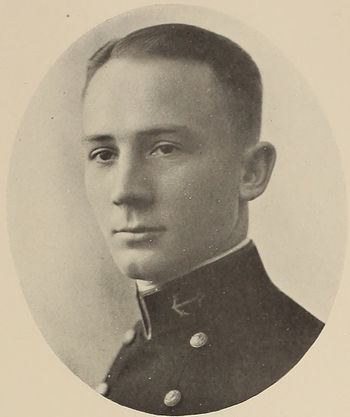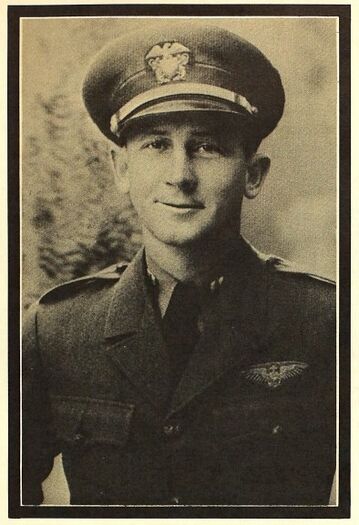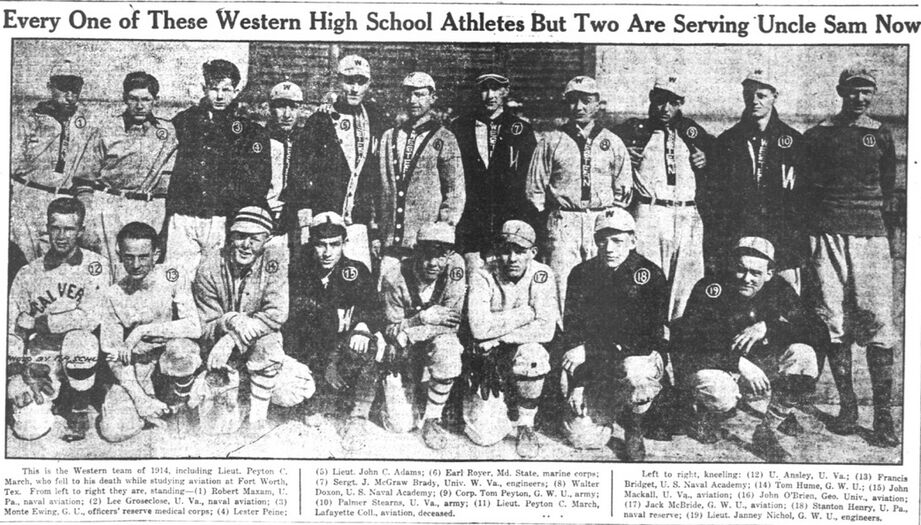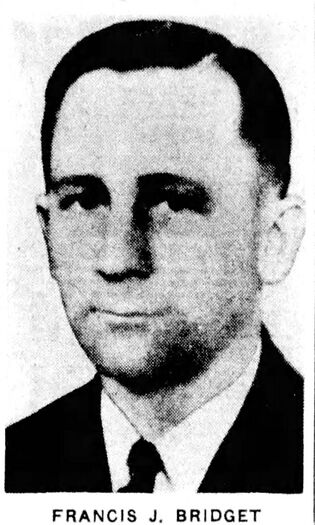FRANCIS J. BRIDGET, CAPT, USN
Francis Bridget '21
Lucky Bag
From the 1921 Lucky Bag:
Francis Joseph Bridget
Washington, D.C.
"Frank" "Deacon" "Deak"
"WHAT! You're tired of Fats? Well then try one of these Tarrytowns. I'm telling you, it's the only cigarette. Get me?" When we hear the above, as we often do, we know that the Deacon has arrived. In appearance he is all that his nom d'entaille implies, but we who have seen him at the Army game and thereafter can tell a different story. Just ask him how he liked "Apple Blossom!" And at many other times one would wonder how he had come to get his cognomen, especially when he sallies forth as S. O. P. of the Terpsichorean squadron at every Saturday night gathering. We have come to the conclusion that the bump on the south side of his cranium, as he faces north, is not a superfluous ornament, for when it comes to engineering affairs of importance, he works with such will and enthusiasm that he always has the satisfaction of knowing that he has accomplished something; for it was largely due to his untiring efforts and spirit that track became more fully recognized as the important sport that it is, and as for the June Ball—well—"You tell 'em River, I can't Bridg-et!"
Buzzard; Track Squad (4, 3); Manager Track (2); Hop Committee (3, 2, 1); Chairman Hop Committee (1); Chairman June Ball (3, 2); Swimming Squad (2).
The Class of 1921 was the last of the wartime-accelerated classes. "1921A" was graduated on June 3, 1920; the second half, "1921B", was graduated on June 2, 1921. Francis was graduated with 1921B.

Francis Joseph Bridget
Washington, D.C.
"Frank" "Deacon" "Deak"
"WHAT! You're tired of Fats? Well then try one of these Tarrytowns. I'm telling you, it's the only cigarette. Get me?" When we hear the above, as we often do, we know that the Deacon has arrived. In appearance he is all that his nom d'entaille implies, but we who have seen him at the Army game and thereafter can tell a different story. Just ask him how he liked "Apple Blossom!" And at many other times one would wonder how he had come to get his cognomen, especially when he sallies forth as S. O. P. of the Terpsichorean squadron at every Saturday night gathering. We have come to the conclusion that the bump on the south side of his cranium, as he faces north, is not a superfluous ornament, for when it comes to engineering affairs of importance, he works with such will and enthusiasm that he always has the satisfaction of knowing that he has accomplished something; for it was largely due to his untiring efforts and spirit that track became more fully recognized as the important sport that it is, and as for the June Ball—well—"You tell 'em River, I can't Bridg-et!"
Buzzard; Track Squad (4, 3); Manager Track (2); Hop Committee (3, 2, 1); Chairman Hop Committee (1); Chairman June Ball (3, 2); Swimming Squad (2).
The Class of 1921 was the last of the wartime-accelerated classes. "1921A" was graduated on June 3, 1920; the second half, "1921B", was graduated on June 2, 1921. Francis was graduated with 1921B.
Loss
From Find A Grave:
Capt Francis Bridget was held as a POW in the Philippine Islands. In December 1944, he was boarded onto the Oryoku Maru for transport to Japan. The ship was sunk by American planes at Subic Bay, Philippine Islands, on December 15, 1944. The surviving POWs were boarded onto the Enoura Maru which reached Takao, Formosa. While docked it was bombed by American planes on January 9, 1945, killing many of the POWs. The surviving POWs were boarded onto the Brazil Maru, It was while he was on the ship that he died from wounds he received, on the Enoura Maru, before the ship reached Japan on January 29, 1945.
Note that some records, including his Prisoner of War Medal below, indicate he perished on Oryoku Maru. However, this site—which has much more detailed records of the "Hell Ships"—lists his date of death as January 23, 1945. There is also first-person testimony that he was alive, though wounded, following the attack.
Photographs
Other Information
From researcher Kathy Franz:
Francis graduated in 1916 from Western high school as the senior class president. He was the track captain and a member of Pi Phi Fraternity. He also attended Columbian Prep School.
On May 9, 1930, Francis, as an American assistant naval attaché, attended a luncheon in Tokyo given by the American naval attaché Captain H. M. Bemis in honor of Commander Earle Kincaid and Lieut. A. H. Oswald who were returning to Washington after four years with the Asiatic station. Others in attendance were the Soviet, Italian, French, and German naval attaches; the British, French, German and Italian air attaches, and the Dutch attaches.
On July 28, 1928, he married Charlotte Ballou in Pensacola. She died in San Francisco in October, 1980, and was buried at sea. Their daughter was Charlotte, born in 1929. Charlotte’s first daughter was Barbara Young, born in 1922. Charlotte divorced her first husband Lieut. Parke George Young (’21) in 1927.
In April 1939, Francis and his family sailed from Yokohama to San Francisco.
His father Bernard of the firm Parker-Bridget Company was a clothing store merchant, and his mother was Mary. Francis’ four sisters were: Mary Bernadine, Mary R., Helen (Mrs. William Hepburn, wife of the dean of the Tuscaloosa University Law school), and Josephine.
His three brothers were John, Henry James, and Bernard. Bernard broke his leg when he parachuted from an Army air service plane that he piloted in May, 1927.
From Navsource:
Francis Joseph Bridget was born in Washington, D.C. on 02 August 1897, the son of Bernard M. and Josephine (Moore) Bridget, He attended the Columbian Preparatory School in Washington prior to his appointment to the U.S. Naval Academy. Graduated and commissioned Ensign on 03 June 1921, he subsequently advanced in rank, attaining that of Commander. He was posthumously appointed Captain by the Secretary of the Navy on 28 August 1945. He was awarded the Navy Cross and the Army Silver Star Medals, and cited as follows:
Navy Cross: "For extraordinary heroism and courage during operations against Japanese forces in December 1941. Although subjected to repeated and sustained enemy aerial attacks, Commander Bridget rendered outstanding service under extremely hazardous and difficult conditions..."
Army Silver Star Medal: "For gallantry in action in the vicinity of Bataan, on 29 January 1942. On his own initiative and volition, and despite the hazards of hostile aerial attack and artillery fire, Commander Bridget accompanied an expedition aboard USS Quail, with the mission in conjunction with ground troops, of dislodging enemy forces established in a strategic area. The display of fearless devotion to duty revealed by this officer during the entire operation, as well as his superior seamanship and gunnery contributed in a large measure to the successful destruction of the enemy forces."
On 17 June 1943, Captain Bridget was reported a "prisoner of war", and on 15 December 1944 was lost on board a Japanese prison ship sunk off Olongapo, Luzon, Philippine Islands. "For exceptionally meritorious conduct... while aboard Japanese prison ship, until that vessel was sunk...", he was awarded the Legion of Merit posthumously.
"Self-sacrificing and constant in his concern for others, Commander Bridget made every effort to maintain discipline among the 800 American prisoners-of-war packed into the airless, humid holds of the ships, rendering valiant service in sustaining the morale of the starving, panic-stricken men. With conditions rapidly becoming more acute and the men growing weaker, (he) who could speak some Japanese, repeatedly risked his life to go topside, to endeavor to negotiate with the enemy and alleviate the situation for his trapped companions. Aware that certain death awaited any man attempting to leave the hold when the ship was subjected to the first of a series of attacks, he warned that attempted escape might lead to a mass slaughter by the Japanese and calmly assured the frantic prisoners that if the vessel sank all would be able to abandon ship before it went down..."
In addition to the Navy Cross, the Army Silver Star Medal, and the Legion of Merit, Captain Bridget was entitled to the Purple Heart Medal, the Victory Medal, Atlantic Fleet Clasp (WW I); the American Defense Service Medal; and the Philippine Defense Ribbon.
From the Evening Star, Washington, D. C., May 23, 1942, via researcher Kathy Franz:
San Francisco, May 23. – How a handful of bluejackets and marines, assisted later by Philippine Scouts, cleared out a secret nest of Japanese threatening capture of a Navy section base in the islands was related yesterday by Col. William T. Clement of the Marine Corps.
The incident occurred late in January, shortly after Gen MacArthur had completed his withdrawal to Bataan.
Well to the south, where there were no defending troops, Comdr. Francis Bridget discovered the enemy had built up a force of hand-picked men on Longaskayan Point at the southern tip of the peninsula, only a mile from the section base at Mariveles.
“They were living in caves, hiding night and day until they could be reinforced to the point where an attack on the base could be made successfully,” Col. Clement told interviewers.
“Comdr. Bridget of the Navy Air corps rounded up all the sailors and marines he could find and formed a battalion to rout them out.
“I joined him the next morning and we had fought there five days when the 2d Battalion of the 5th Philippine Scouts, the best fighting men I have ever known, joined us.
“Then, after three more days’ fighting, we cleaned out the Japs – there were some 200 of them – to the last man.”
Col. Clement said the Japanese had been chosen not only for their skill and aggressiveness as fighters, but also for their knowledge of English.
“They would talk English at night and when our men, lured into thinking buddies were near at hand, went to join them, they would shoot us down.
“Other times, parties of them would cry, ‘We’ve had enough, we give up,’ and when we moved in to capture them, we would be shot from the side.”
Francis was initially evacuated from Corregidor with other Navy and Army officers and nurses on April 29, 1942 by a PBY Catalina float plane. That aircraft flew to Lake Lana on Mindanao Island in the southern Philippines to refuel and take on additional evacuees. At some point during this the plane struck a submerged rock and was unable to depart. Once repaired, the aircraft left without its passengers; the lake was surrounded and Francis and the others became prisoners of war on May 11, 1942.
His wife, Charlotte, was listed as next of kin.
Career
In the Bureau of Naval Personnel Information Bulletin No. 141 (September 27, 1930) Francis was listed as a member of Fighting Plane Squadron Five:
Major General Frank Parker, Commanding the Sixth Corps Area, Chicago, Ill., recently addressed the following letter to the Chief of the Bureau of Aeronautics:
"My dear Admiral:
"It is a most agreeable duty for me to express to you, officially, my admiration for the great feats performed by your Navy Air Force during the recent Air Meet in this City.
The work has been so fine, both in the case of the officers of the flying personnel and of those officers and men connected with the upkeep of the planes, that I would be glad to have each member of the personnel furnished a copy of this letter as a testimonial of the Army's admiration for the skill and courage of these representatives of the Air Force of the Navy."
Francis was a naval attaché in Tokyo in 1939, he then was the re-commissioning commanding officer of USS William B. Preston (AVP 20) from June 1940 to June 1941.
Prior to the war, he was operations officer and chief of staff, Patrol Wing 10. Once that command ceased to exist, he—a patrol bomber pilot who had never led troops—became the commanding officer of the Naval Battalion on Bataan and later Corregidor.
From US Navy History:
Besides the Army, the Navy also had a vital role in the Battle of Bataan. The southern tip of the Bataan peninsula was the Navy Section Base at Mariveles. That was the headquarters for the 16th Naval District commanded by Rear Admiral Francis W. Rockwell, who had the mission of protecting “the naval stations on the island of Luzon, primarily Olongapo and the Navy Section Base at Mariveles.”[13] In January 1942, “the only naval facilities remaining in the Philippines were at Mariveles. Here all the unattached naval personnel were congregated.”[14] They were placed under the command of Commander Francis J. Bridget, known as “Fidgety Frank,” who was a PBY aviator with no troop leading experience. Commander Bridget formed them into a naval battalion totaling 602 sailors and also marines from the 4th Marine Regiment which had redeployed to the Philippines from its longtime duty station in Shanghai, China in late November 1941.
The naval battalion was tasked to provide local security for the Mariveles naval station which was located at the Southern tip of the Bataan peninsula. The immediate area to the Southwest of Mariveles was a series of bays on the Southwest coast of Bataan adjacent to a high ridge which overlooks the Mariveles harbor and naval station. “A landing on any of the bays to the South could quickly secure the high ground behind the naval station thus cutting the only supply road on Bataan and rendering the naval facilities untenable.”[15] That key terrain was also only five miles from General MacArthur’s Headquarters. The battle began when the Japanese troops landed at Longoskawayan and Quinauan Points on the southwest coast of Bataan. Those landings were executed simultaneously when the USAFFE forces withdrew from its main line of resistance, the Abucay Line to its reserve defense line further south down the peninsula. The naval battalion was the only opposing force available for defense of the USAFFE rear echelon areas. Commander Bridget had to take a battalion of inexperienced sailors and had only two weeks to have them trained in basic infantry skills done by a handful of marines. Most of these sailors never received basic weapons marksmanship training in their naval careers and were expected to fight elite Japanese army troops. However, the naval battalion managed to contain the Japanese attack with the utmost courage and ferocity, but was unable to successfully counterattack and drive the Japanese back to the sea. The USAFFE 57th Infantry Regiment (Philippine Scouts) was able to relieve the naval battalion at the decisive point of the battle and push the Japanese landing force back to the South China Sea.
"Comdr. FJB" — almost certainly Francis — is mentioned on page 12 of Carter Simpson '39's incredible diary. Francis "arrived and presented us with a bottle of Scotch -- it surely was good" following the downing of an attacking Japanese plane.
Much later, in his final days, from Last of the Oryoku Maru:
They stacked their dead at the entrance to the court. They moved the tall referee’s platform to the middle of the court, where it became a kind of lookout and command post. Commander Warner Portz was still nominally senior officer, but so exhausting had been the experience he underwent in the aft hold that both he and Commander Frank Bridget were depleted as well as wounded. Leadership was passing into the hands of Beecher, whose forward hold had suffered greatly, but not so much.
"We saw that Bridget and Portz were fading," says one Army Lieutenant. "Their throats were almost gone from shouting orders; you could hardly hear them. Both had body wounds, and Portz was wounded in the head, too. I had never seen bravery and leadership in my life like that of Bridget when men began dying in the hold. As for Portz, I had come to think of him as I would my own father."
From Hall of Valor:
The President of the United States of America takes pleasure in presenting the Navy Cross to Commander Francis Joseph Bridget (NSN: 0-19086), United States Navy, for extraordinary heroism and distinguished service in the line of his profession while serving on the Staff of the Commander of Patrol Wing TEN (PatWing 10), during operations against enemy Japanese forces in the Mariveles Area in December 1941. Although subjected to repeated and sustained enemy aerial attacks, Commander Bridget rendered outstanding services under the extremely hazardous and difficult conditions existing in that area. His skillful leadership and complete disregard for his own personal safety were in keeping with the highest traditions of the United States Naval Service.
Service: Navy
Legion of Merit
From Hall of Valor:
The President of the United States of America takes pride in presenting the Legion of Merit (Posthumously) to Commander Francis Joseph Bridget (NSN: 0-19086), United States Navy, for exceptionally meritorious conduct in the performance of outstanding services to his fellow prisoners of war in the hold of the Japanese Prison Ship, Oraku-Maru, from the time it sailed from Manila, 13 December 1944 until shortly before the ship was sunk off Olongapo on 15 December 1944. Commander Bridget helped maintain sufficient discipline among the half-mad, panic stricken prisoners in the hold when the ship was first bombed. Such an attempt would have resulted in the mass slaughter of the prisoners by the Japanese. At considerable risk to himself, Commander Bridget, who can speak some Japanese, made persistent requests to the Japanese to alleviate the conditions of the prisoners in the hold. While he was not successful he tried as well as anyone could to persuade the Japanese to open the ventilators that the prisoners might not smother to death; to provide food, to provide water that the men might not die from thirst and dehydration; to provide sanitary facilities and to remove the bodies of the some 200 prisoners who had already smothered in the hold.
Service: Navy
Rank: Commander
Prisoner of War Medal
From Hall of Valor:
Commander Francis Joseph Bridget (NSN: 0-19086), United States Navy, was captured by the Japanese after the fall of Corregidor, Philippine Islands, on 6 May 1942, and was held as a Prisoner of War until in death in captivity on or about 15 December 1944.
General Orders: NARA Database: Records of World War II Prisoners of War, created, 1942 - 1947
Service: Navy
Rank: Commander
Note that almost none of this is correct; he was not taken prisoner on Corregidor, he was not taken prisoner on May 6, and he did not die in December 1944.
Defenders of the Rock
Francis is included in the book Defenders of the Rock, by Tim Deal, Spencer Huyck, and Ashley Deal.
Defenders of the Rock preserves the stories of twenty-four individuals who were in the Philippines on December 8, 1941, when war came to the island nation. Their island way of life was shattered in an instant, when the first Japanese bombs exploded. Each story provides a unique perspective on what was occurring to those who were defending the Philippines as they fought back the invaders. They prayed that help would come, but it never arrived. The surrender of the Philippines occurred at noon on Wednesday, May 6, 1942. Of the twenty-four, some would escape capture only to die later during the war, others would become prisoners of war and survive, and others would die in captivity. Some would be tortured and live, while one of them was executed. These twenty-four serve as ambassadors whose courage, honor, and sacrifice represent the thousands of other similar stories we could not include.
Eight of the men featured in the book are Naval Academy alumni; Bethel Otter '37 and Carter Simpson '39 are also in Memorial Hall.
The "Register of Commissioned and Warrant Officers of the United States Navy and Marine Corps" was published annually from 1815 through at least the 1970s; it provided rank, command or station, and occasionally billet until the beginning of World War II when command/station was no longer included. Scanned copies were reviewed and data entered from the mid-1840s through 1922, when more-frequent Navy Directories were available.
The Navy Directory was a publication that provided information on the command, billet, and rank of every active and retired naval officer. Single editions have been found online from January 1915 and March 1918, and then from three to six editions per year from 1923 through 1940; the final edition is from April 1941.
The entries in both series of documents are sometimes cryptic and confusing. They are often inconsistent, even within an edition, with the name of commands; this is especially true for aviation squadrons in the 1920s and early 1930s.
Alumni listed at the same command may or may not have had significant interactions; they could have shared a stateroom or workspace, stood many hours of watch together… or, especially at the larger commands, they might not have known each other at all. The information provides the opportunity to draw connections that are otherwise invisible, though, and gives a fuller view of the professional experiences of these alumni in Memorial Hall.
May 1923
July 1923
September 1923
November 1923
January 1924
July 1924
September 1924
November 1924
January 1925
March 1925
July 1925
October 1925
January 1926
October 1926
January 1927
April 1927
January 1928
April 1928
July 1928
October 1928
January 1929
LT Edwin Conway '20
LT LaRue Lawbaugh '20
LT Stephen Cooke '21
LT James Carney '21
LT John Jones '21
LTjg William Davis '22
LT James Craig '22
April 1929
LT LaRue Lawbaugh '20
LT James Carney '21
LT John Jones '21
LTjg William Davis '22
LT James Craig '22
LTjg Walter Leach, Jr. '24
LTjg Hubert Waters '25
LTjg Creighton Lankford '25
ENS Henry G'Sell '26
July 1929
October 1929
January 1930
April 1930
October 1930
LT Edwin Crouch '21 (USS Lexington)
LTjg Burton Doggett '24 (USS Lexington)
LTjg Hilan Ebert '26 (USS Lexington)
ENS William Potts '27 (USS Lexington)
ENS Robert Haven '30 (USS Lexington)
ENS Baylies Clark '30 (USS Lexington)
January 1931
LT Edwin Crouch '21 (USS Lexington)
LTjg Burton Doggett '24 (USS Lexington)
LTjg Hilan Ebert '26 (USS Lexington)
ENS Robert Haven '30 (USS Lexington)
ENS Baylies Clark '30 (USS Lexington)
April 1931
LT James Carney '21 (Fighting Plane Squadron (VF) 2B)
LT Arnold Isbell '21 (Torpedo and Bombing Plane Squadron (VT) 1B)
LT Edwin Crouch '21 (USS Lexington)
LTjg Hilan Ebert '26 (USS Lexington)
LTjg Richard Downer '27 (Scouting Plane Squadron (VS) 3B)
LTjg Elmer Cooper '27 (Torpedo and Bombing Plane Squadron (VT) 1B)
LTjg Robert Winters '27 (Torpedo and Bombing Plane Squadron (VT) 1B)
ENS John Riggs, Jr. '28 (Torpedo and Bombing Plane Squadron (VT) 1B)
ENS Baylies Clark '30 (USS Lexington)
July 1931
October 1931
January 1932
April 1932
October 1932
LCDR Charles Cecil '16
LT Robert Smith '20
LT Paul Register '21
LT George Brooke '21
LT William Hobby, Jr. '23
LTjg Neville McDowell '24
LTjg Hubert Hayter '24
January 1933
LCDR Charles Cecil '16
LT Robert Smith '20
LT Paul Register '21
LT George Brooke '21
LT William Hobby, Jr. '23
LTjg Neville McDowell '24
LTjg Hubert Hayter '24
April 1933
LCDR Charles Cecil '16
LT Robert Smith '20
LT Paul Register '21
LT George Brooke '21
LT William Hobby, Jr. '23
LTjg Neville McDowell '24
LTjg Hubert Hayter '24
LTjg Lawrence McPeake '24
July 1933
October 1933
April 1934
July 1934
October 1934
January 1935
April 1935
October 1935
January 1936
April 1936
July 1936
January 1937
April 1937
September 1937
January 1938
July 1938
January 1939
October 1939
June 1940
November 1940
April 1941
Namesake
USS Bridget (DE 1024) was named for Francis; the ship was sponsored by his widow.
Memorial Hall Error
The biography provided for USS Bridget indicates he was posthumously promoted to Captain; this is also how he is recorded at the Manila American Cemetery and Memorial. Memorial Hall has CDR.

The "category" links below lead to lists of related Honorees; use them to explore further the service and sacrifice of alumni in Memorial Hall.


